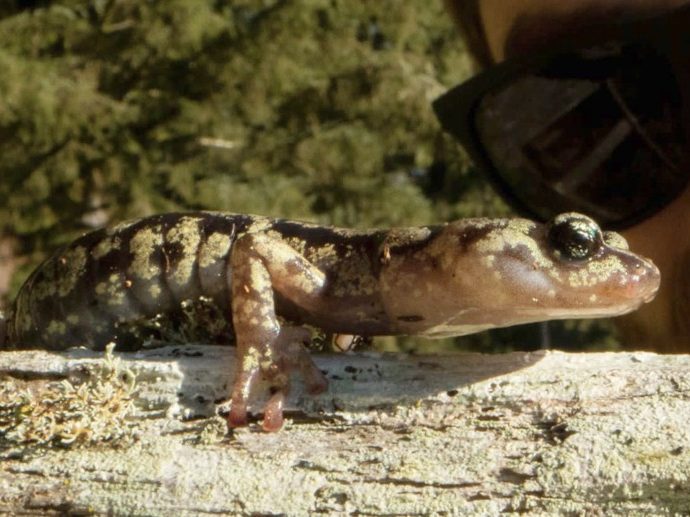The amphibians control their descents without the use of any webbed limbs
In one of the tallest trees on Earth, a tan, mottled salamander ventures out on a fern growing high up on the trunk. Reaching the edge, the amphibian leaps, like a skydiver exiting a plane.
The salamander’s confidence, it seems, is well-earned. The bold amphibians can expertly control their descent, gliding while maintaining a skydiver’s spread-out posture, researchers report May 23 in Current Biology.
Wandering salamanders (Aneides vagrans) are native to a strip of forest in far northwestern California. They routinely climb into the canopies of coast redwoods (Sequoia sempervirens). There — as high as 88 meters up — the amphibians inhabit mats of ferns that grow in a suspended, miniature ecosystem. Unlike many salamanders that typically spend their days in streams or bogs, some of these wanderers may spend their whole lives in the trees.
Integrative biologist Christian Brown was studying these canopy crawlers as a graduate student at California State Polytechnic University, Humboldt in Arcata, when he noticed they would jump from a hand or branch when perturbed.
Now at the University of South Florida in Tampa, Brown and his colleagues wondered if the salamanders’ arboreal ways and proclivity to leap were related, and if the small creatures could orient themselves during a fall.
Brown and his team captured five each of A. vagrans, a slightly less arboreal species (A. lugubris), and two ground-dwelling salamanders (A. flavipunctatus and Ensatina eschscholtzii). The researchers then put each salamander in a vertical wind tunnel to simulate falling from a tree, filming the animals’ movements with a high-speed camera.
In all of 45 trials, the wandering salamanders showed tight control, using their outstretched limbs and tail to maintain a stable position in the air and continually adjusting as they sailed. All these salamanders slowed their descents’ speed, what the researchers call parachuting, using their appendages at some point, and many would change course and move horizontally, or glide.
“We expected that maybe [the salamanders] could keep themselves upright. However, we never expected to observe parachuting or gliding,” Brown says. “They were able to slow themselves down and change directions.”
A. lugubris had similar aerial dexterity to A. vagrans but glided less (36 percent of the trials versus 58 percent). The two ground huggers mostly flailed ineffectively in the wind.
The wandering salamanders’ maneuverable gliding is probably invaluable in the tops of the tall redwoods, Brown says. Rerouting midair to a fern mat or branch during an accidental fall would save the effort spent crawling back up a tree. Gliding might also make jumping to escape a hungry owl or carnivorous mammal a feasible option.
Brown suspects that the salamanders may also use gliding to access better patches to live. “Maybe your fern mat’s drying out, maybe there’s no bugs. Maybe there are no mates in your fern mat, you look down — there’s another fern mat,” Brown says. “Why would you take the time to walk down the tree and waste energy, be exposed and [risk] being preyed upon, when you could take the gravity elevator?”
There are other arboreal salamanders in the tropics, but those don’t live nearly as high as A. vagrans, says Erica Baken, a macroevolutionary biologist at Chatham University in Pittsburgh who was not involved with the research.
“It would be interesting to find out if there is a height at which [gliding] evolves,” she says.
A. vagrans’ relatively flat body, long legs and big feet may allow more control in the air. Brown and his colleagues are now using computer simulations to test how body proportions could impact gliding.
Such body tweaks, if they do turn out to be meaningful, wouldn’t be as conspicuous as the sprawling, membraned forms seen in other animals like flying snakes and colugos that are known for their gliding. There may be many tree-dwelling animals with conventional body plans that have been overlooked as gliders, Brown says. “The canopy world is just starting to unfold.”





















